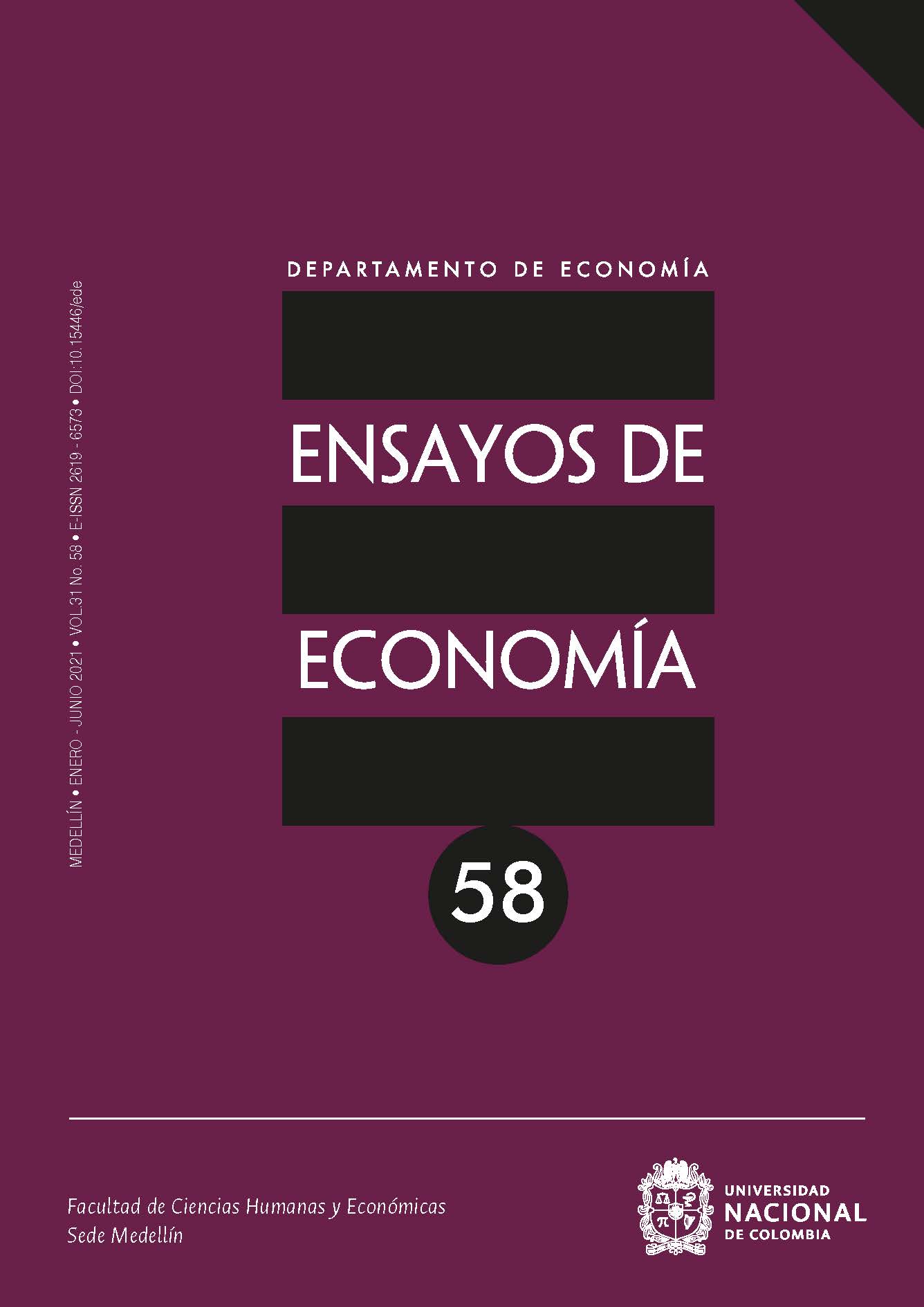Determinantes de la autonomía local en la gestión del trabajo en empresas multinacionales. El caso de las subsidiarias argentinas
Determinants of Local Autonomy in the Management of Work in Multinational Companies. The Case of Argentine Subsidiaries
DOI:
https://doi.org/10.15446/ede.v31n58.88667Palabras clave:
Autonomía local, Gestión del trabajo, Filiales, Empresas Multinacionales, Argentina (es)Local autonomy, Subsidiaries, Multinational Companies, Argentina, work management (en)
Descargas
El objetivo de este artículo es analizar los factores determinantes de la autonomía local en gestión del trabajo de subsidiarias de empresas multinacionales en Argentina. A partir de la literatura especializada, se plantean hipótesis tomando las siguientes variables explicativas: país de origen, forma de ingreso al mercado local, integración con la casa matriz y otras filiales, existencia de divisiones intermedias de toma de decisiones, grado de transnacionalización y nivel de afiliación sindical. El análisis se basa en una encuesta aplicada entre los años 2016 y 2017 a filiales, y parte por identificar mediante un análisis de aglomeración dos grupos de empresas según su autonomía. Posteriormente, se realiza un análisis de regresión logística y adicionalmente se presenta un análisis de efectos marginales que permiten una mejor interpretación de la incidencia de cada variable explicativa sobre la dependiente. Los resultados econométricos indican que las empresas de origen estadounidense, con mayor nivel de transnacionalización y divisiones regionales reducen la probabilidad de tener alta autonomía en la gestión de la fuerza de trabajo. En cambio, la vinculación comercial con la red multinacional incide positivamente en la probabilidad de que las empresas tengan alta autonomía local en las prácticas de empleo de las subsidiarias.
The objective of this article is to analyze the determining factors of local autonomy in the management of work at subsidiaries of multinational companies in Argentina. Based on specialized literature, hypotheses are formulated taking the following explanatory variables: country of origin, form of entry into local market, integration with head quarters and other subsidiaries, existence of intermediary divisions in decision making, degree of transnationalism at the level of union affiliation. The analysis is based on a survey applied between 2016 and 2017 at subsidiaries, it begins by identifying through an agglomeration analysis two groups of companies according to their autonomy. Later, an analysis is carried out of the marginal effects that allow an improved interpretation of the incidence of each explanatory variable on the dependent. The econometric results indicate that American companies, with a higher level of transnationalism and regional divisions reduce the probability of having a high autonomy in the management of their work force. On the other hand, commercial connection with the multinational network has a positive effect on the probability that the companies have a high local autonomy in the subsidiaries’ work practices.
Referencias
Agresti, A. (2007). An Introduction to Categorical Data Analysis (2º ed.). John Wiley & Sons.
Almond, P., Edwards, T., Colling, T., Ferner, A., Gunnigle, P., Müller-Camen, M., Quintanilla, J. & Wächter, H. (2005). Unraveling Home and Host Country Effects: An Investigation of the HR Policies of an American Multinational in Four European Countries. Industrial Relations. A Journal of Economy and Society, 44 (2), 276–306. https://doi.org/10.1111/j.0019-8676.2005.00384.x
Almond, P. & Ferner, A. (eds.). (2006). American Multinationals in Europe. Oxford University Press.
Andersson, U. & Forsgren, M. (1996). Subsidiary Embeddedness and Control in the Multinational Corporation. International Business Review, 5(5), 487–508. https://doi.org/10.1016/0969-5931(96)00023-6
Bartram, T., Boyle, B., Stanton, P., Sablok, G. & Burgess, J. (2015). Performance and Reward Practices of Multinational Corporations Operating in Australia. Journal of Industrial Relations, 57(2) 210–231. https://doi.org/10.1177/0022185614564372
Beechler, S. & Yang, J. Z. (1994). The Transfer of Japanese-Style Management to American Subsidiaries: Contingencies, Constraints, and Competencies. Journal of International Business Studies, 25(3), 467–491. https://www.jstor.org/stable/155355
Bélanger, J., Lévesque, C., Jalette, P. & Murray, G. (2013). Discretion in Employment Relations Policy among Foreign-Controlled Multinationals in Canada. Human Relations, 66(3), 307-332. https://doi.org/10.1177/0018726712457194
Belizón, M. J., Gunnigle, P. & Morley, M. J. (2013). Determinants of Central Control and Subsidiary Autonomy in HRM: The Case of Foreign-Owned Multinational Companies in Spain. Human Resource Management Journal, 23(3), 262-278. https://doi.org/10.1111/j.1748-8583.2012.00204.x
Belizón, M. J., Morley, M. J. & Gunnigle, P. (2015). On Institutional and Organisational Determinants of Human Resource Management and Industrial Relations in Foreign-owned Multinational Subsidiaries: A Comparative Analysis in Ireland and Spain Using a Quantitative Parallel Design [tesis doctoral, Universidad de Limerick]. https://ulir.ul.ie/handle/10344/4779
Belizón, M. J., Morley, M. J. & Gunnigle, P. (2016). Modes of Integration of Human Resource Management Practices in Multinationals. Personnel Review, 45(3), 539-556. https://doi.org/10.1108/PR-09-2014-0207
Borkowski, S. C. (1999). International Managerial Performance Evaluation: A Five Country Comparison. Journal International Business Studies, 30, 533–555. https://doi.org/10.1057/palgrave.jibs.8490082
Brandt, W. K. & Hulbert, J. M. (1977). Headquarters Guidance in Marketing Strategy in The Multinational Subsidiary. Columbia Journal of World Business, 12, 7–14. https://doi.org/10.1002/tie.5060200307
Brewster, C., Mayrhofer, W. & Smale, A. (2016). Crossing the Streams: HRM in Multinational Enterprises and Comparative HRM. Human Resource Management Review, 26(4), 285-297. https://doi.org/10.1016/j.hrmr.2016.04.002
Button, K. S., Ioannidis, J. P. A., Mokrysz, C., Nosek, B. A., Flint, J., Robinson, E. S. J. & Munafò, M. R. (2013). Power Failure: Why Small Sample Size Undermines the Reliability of Neuroscience. Nature Reviews Neuroscience, 14, 365–376. https://doi.org/10.1038/nrn3475
Cameron, A. C. & Trivedi, P. K. (2009). Microeconometrics Using Stata. Stata Press.
Delfini, M., Cretini, I. & Quadrana, A. (2018). Los determinantes del pago por rendimiento en filiales argentinas de empresas multinacionales. Estudios Gerenciales, 34(149), 411-421. https://doi.org/10.18046/j.estger.2018.149.2872
Djelic, M. L. & Quack, S. (eds.). (2003). Globalization and Institutions. Redefining the Rules of the Economic Game. Edward Elgar.
DiMaggio, P. J. & Powell, W. W. (1983). The Iron Cage Revisited: Institutional Isomorphism and Collective Rationality in Organizational Fields. American Sociological Review, 48, 147–60. https://doi.org/10.2307/2095101
Epstein, M. J. & Roy, M. J. (2007). Implementing a Corporate Environmental Strategy: Establishing Coordination and Control within Multinational Companies. Business Strategy Environment, 16, 389–403. https://doi.org/10.1002/bse.545
Edwards, T. & Ferner, A. (2004). Multinationals, Reverse Diffusion and National Business Systems. En D. M. Brock & J. Birkinshaw (eds.), Management International Review (pp. 49-79). Gabler Verlag. https://doi.org/10.1007/978-3-322-90999-2_4
Edwards, T., Marginson, P. & Ferner, A. (2013). Multinational Companies in Cross-National Context: Integration, Differentiation, and the Interactions between MNCs and Nation States. Industrial and Labor Relations Review, 66(3), 547-587. https://doi.org/10.1177/001979391306600301
Edwards, T., Gunnigle, P., Quintanilla, J. & Wätcher, H. (2006). Overview of the Host Business Systems. En P. Almond & A. Ferner (eds.), American Multinationals in Europe (pp. 57–65). Oxford University Press.
Everitt, B. S., Landau, S., Leese, M. & Stahl, D. (2011). Cluster Analysis. John Wiley & Sons.
Fenton-O'Creevy, M., Gooderham, P. & Nordhaug, O. (2008). Human Resource Management in US Subsidiaries in Europe and Australia: Centralisation or Autonomy? Journal of International Business Studies, 39(1), 151-166. https://doi.org/10.1057/palgrave.jibs.8400313
Ferner, A., Bélanger, J., Tregaskis, O., Morley, M. & Quintanilla, J. (2013). U.S. Multinationals and the Control of Subsidiary Employment Policies. Industrial and Labor Relations Review, 66(3), 645–696. http://www.jstor.org/stable/24369504
Ferner, A., Tregaskis, O., Edwards, P., Edwards, T., Marginson, P., Duncan, A. & Meyer, M. (2011). HRM Structures and Subsidiary Discretion in Foreign Multinationals in the UK. The International Journal of Human Resource Management, 22(03), 483-509. https://doi.org/10.1080/09585192.2011.543628
Festing, M. & Tekieli, M. (2018). Global Alignment or Localization? An Empirical Examination of Global Reward Management in MNEs from a Subsidiary Perspective. The International Journal of Human Resource Management, 29 (22). https://doi.org/10.1080/09585192.2018.1504107
Freeman, D. H. (1987). Applied Categorical Data Analysis. Marcel Dekker.
Forsgren, M., Pedersen, T. & Foss, N. (1999). Accounting for the Strength of MNC Subsidiaries: The Case of Foreign-owned Firms in Denmark. International Business Review, 8(2), 181-96. https://doi.org/10.1016/S0969-5931(98)00044-4
Gereffi, G., Humphrey, J. & Sturgeon, T. (2005). The Governance of Global Value Chains. Review of International Political Economy, 12(1), 78-104. https://doi.org/10.1080/09692290500049805
Ghoshal S, & Bartlett, C. (1990). The Multinational Corporation as an Interorganizational Network. Academy of Management, 15(4), 603–625. https://doi.org/10.5465/amr.1990.4310825
Guillén, M. (2001). Is Globalization Civilizing, Destructive or Feeble? A Critique of Five Key Debates in the Social Science Literature. Annual Review of Sociology, 27, 235–60. https://doi.org/10.1146/annurev.soc.27.1.235
Gunnigle, P., Lavelle, J. & McDonnell, A. (2007). Industrial Relations in Multinational Companies (MNCs): Double Breasting and Trade Union Avoidance in Ireland [Working Paper, Department of Personnel and Employment Relations, Kemmy Business School]. University of Limerick. https://doi.org/10.2139/ssrn.1132759
Hair, J., Black, W., Babin, B. & Anderson, R. (2010). Multivariate Data Analysis. Pearson.
Hamill, J. (1984). Labour Relations Decision Making within Multinational Corporations. Industrial Relations Journal, 15(2), 30-34. https://doi.org/10.1111/j.1468-2338.1984.tb00478.x
Han, J., Kamber, M. & Pei, J. (2011). Data Mining: Concepts and Techniques (3º ed.). Morgan Kaufmann Publishers.
Hanmer, M. J. & Ozan Kalkan, K. (2012). Behind the Curve: Clarifying the Best Approach to Calculating Predicted Probabilities and Marginal Effects from Limited Dependent Variable Models. American Journal of Political Science, 57(1), 263–277. https://doi.org/10.1111/j.1540-5907.2012.00602.x
Harzing, A. W. (1999). Managing the Multinationals: An International Study of Control Mechanisms. Edward Elgar.
Hoetker, G. (2007). The Use of Logit and Probit Models in Strategic Management Research: Critical Issues. Strategic Management Journal, 28(4), 331–343. https://doi.org/10.1002/smj.582
Holm, U., & Pedersen, T. (eds.). (2000). The Emergence and Impact of MNC Centers of Excellence: A Subsidiary Perspective. Macmillan.
Johnston, S. (2005). Headquarters and Subsidiaries in Multinational Corporations. Strategies, Tasks and Coordination. Springer. https://doi.org/10.1057/9780230511002
Johnston, S. & Menguc, B. (2007). Subsidiary Size and the Level of Subsidiary Autonomy in Multinational Corporations: A Quadratic Model Investigation of Australian Subsidiaries. Journal of International Business Studies, 38(5), 787-801. https://doi.org/10.1057/palgrave.jibs.8400294
Kassambara, A. (2017). Practical Guide to Cluster Analysis in R. Unsupervised Machine Learning. CreateSpace Independent Publishing Platform.
Kihn, L. A. (2008). The Determinants of Multiple Forms of Controls in Foreign Subsidiary Manager Evaluations. International Journal Account Audit Performance Evaluation, 5(2), 157–182. https://doi.org/10.1504/IJAAPE.2008.020848
Kosacoff, B., López, A. & Pedrazzoli, M. (2007). Comercio, inversión y fragmentación del comercio global: ¿está quedando atrás América Latina? [Serie Estudios y Perspectivas Nº 39]. CEPAL. https://repositorio.cepal.org/bitstream/handle/11362/4864/S0700429_es.pdf?sequence=1&isAllowed=y
Kostova, T., & Roth, K. (2002). Adoption of an Organizational Practice by Subsidiaries of Multinational Corporations: Institutional and Relational Effects. Academy of Management Journal, 45(1), 215–233. https://doi.org/10.2307/3069293
Lado, A, & Wilson, M. (1994). Human Resource Systems and Sustained Competitive Advantage: A Competency Based Perspective. Academy of Management Review, 19, 699-727. https://doi.org/10.2307/258742
Levitt, T. (1983). The Globalization of Markets. Harvard Business Review, 61(3), 92–102. https://hbr.org/1983/05/the-globalization-of-markets
Martínez, J. & Jarillo, J. C. (1989). The Evolution of Research on Coordination Mechanisms in Multinational Corporations. Journal of International Business Studies, 20(3), 489–514. https://doi.org/10.1057/palgrave.jibs.8490370
McDonald, F., Tüselmann, H. & Heise, A. (2003). Employee Relations in German Multinationals in an Anglo-Saxon Setting: Toward a Germanic Version of the Anglo-Saxon Approach. European Journal of Industrial Relations, 9(3), 327–349. https://doi.org/10.1177/09596801030093005
Meardi, G., Marginson, P., Fichter, M., Frybes, M., Stanojevic, M. & Toth, A. (2009). Varieties of Multinationals: Adapting Employment Practices in Central Eastern Europe. Industrial Relations, 48(3), 489-511. https://doi.org/10.1111/j.1468-232X.2009.00570.x
Menard, S. (2001). Applied Logistic Regression Analysis (2º ed.). [Sage University Papers Series on Quantitative Applications in the Social Sciences, 106]. Thousand Oaks: Sage Publications. https://us.sagepub.com/en-us/nam/book/applied-logistic-regression-analysis-0#contents
Müller, M. (1998). Human Resource and Industrial Relations Practices of UK and US Multinationals in Germany. The International Journal of Human Resource Management, 9(4), 732–749. https://doi.org/10.1080/095851998340982
Newburry, W. (2001). MNC Interdependence and Local Embeddedness: Influences on Perceptions of Career Benefits from Global Integration. Journal of International Business Studies, 32(3), 497–507. https://doi.org/10.1057/palgrave.jibs.8490980
O´Brien, R. M. (2007). A Caution Regarding Rules of Thumb for Variance Inflation Factors. Quality & Quantity, 41, 673–690. https://doi.org/10.1007/s11135-006-9018-6
O’Donnell, S. W. (2000). Managing Foreign Subsidiaries: Agents of Headquarters, or an Interdependent Network? Strategic Management Journal, 21, 525–548. https://doi.org/10.1002/(SICI)1097-0266(200005)21:5<525::AID-SMJ104>3.0.CO;2-Q
Picard, J. (1977). How European Companies Control Marketing Decisions Abroad. Columbia Journal of World Business, 12, 113–121. https://doi.org/10.1002/tie.5060200106
Pudelko, M. & Harzing, A. W. (2007). The Golden Triangle for MNCs: Standardization Towards Headquarters Practices, Standardization Towards Global Best Practices and Localization. Organizational Dynamics, 37(4), 394–404. https://doi.org/10.1016/j.orgdyn.2008.07.002
Rosenweig, P. M. & Nohria, N. (1994). Influences on Human Resource Management Practices in Multinational Corporations. Journal of International Business Studies, 25(2), 229–251. https://doi.org/10.1057/PALGRAVE.JIBS.8490199
Sageder, M. & Feldbauer‑Durstmüller, B. (2018). Management Control in Multinational Companies: A Systematic Literature Review. Review of Managerial Science, 13, 875–918. https://doi.org/10.1007/s11846-018-0276-1
Sheskin, D. (2003). Handbook of Parametric and Nonparametric Statistical Procedures. Chapman and Hall/CRC.
Singh, S., Darwish, T., Wood, G. & Fattaah, A. (2016). Control Mechanisms of MNEs: An Empirical Study. Multinational Business Review, 24(3), 279-300. https://doi.org/10.1108/MBR-07-2016-0027
Strudenmund, A. H. & Cassidy, H. (1987). Using Econometrics: A Practical Guide. Little Brown.
Taggart, J. H. & Hood, N. (1999). Determinants of Autonomy in Multinational Corporation Subsidiaries. European Management Journal, 17(2), 226–236. https://doi.org/10.1016/S0263-2373(98)00081-4
Tang, W., He, H. & Tu, X. M. (2012). Applied Categorical and Count Data Analysis. Taylor & Francis.
Tempel, A., Edwards, T., Ferner, A., Müller-Camen, M. & Wachter, H. (2006). Subsidiary Responses to Institutional Duality: Collective Representation Practices of US Multinationals in Britain and Germany. Human Relations, 59(11), 1543-1570. https://doi.org/10.1177/0018726706072863
Williams, R. (2012). Using the Margins Command to Estimate and Interpret Adjusted Predictions and Marginal Effects. The Stata Journal, 12(2), 308–331. https://doi.org/10.1177/1536867X1201200209
Wooldridge, J. M. (2010). Econometric Analysis of Cross Section and Panel Data (2º ed). The MIT Press.
Yeung, H., Poon, J., & Perry, M. (2001). Towards a Regional Strategy: The Role of Regional Headquarters of Foreign Firms in Singapore. Urban Studies, 38(1), 157–183. https://doi.org/10.1080/00420980124278
Young, S. & Tavares, T. (2004). Centralization and Autonomy: Back to the Future. International Business Review, 13(2), 215–237. https://doi.org/10.1016/j.ibusrev.2003.06.002
Zhu, J. (2019). Chinese Multinationals’ Approach to International Human Resource Management: A Longitudinal Study. The International Journal of Human Resource Management, 30(14), 2166-2185. https://doi.org/10.1080/09585192.2018.1539860
Zhu, J. S., Zhu, C. J. & De Cieri, H. (2014). Chinese MNCs’ Preparation for Host-Country Labor Relations: An Exploration of Country-of-Origin Effect. Human Resource Management, 53(6), 947–965. https://doi.org/10.1002/hrm.21613
Cómo citar
APA
ACM
ACS
ABNT
Chicago
Harvard
IEEE
MLA
Turabian
Vancouver
Descargar cita
Licencia
Derechos de autor 2021 Ensayos de Economía

Esta obra está bajo una licencia internacional Creative Commons Atribución-NoComercial-SinDerivadas 4.0.
Se autoriza la reproducción sin ánimo de lucro de los materiales, citando la fuente.


























